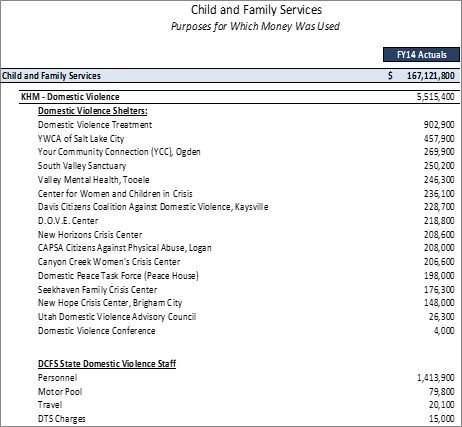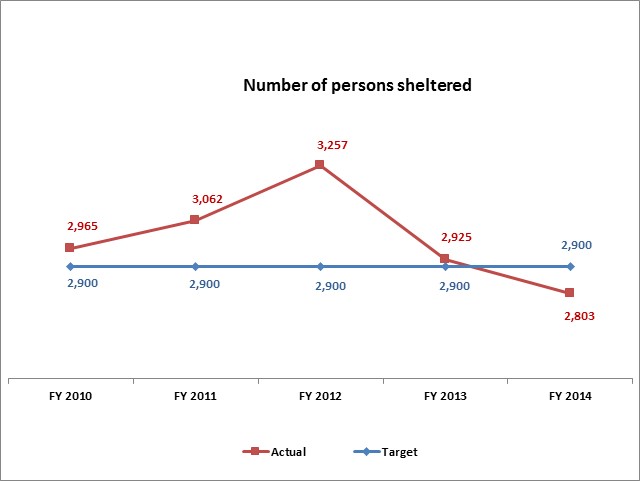The Division of Child and Family Services also provides services which aid victims and perpetrators of domestic violence.
During the 2015 General Session, the Legislature appropriated for Fiscal Year 2016, $6,867,900 from all sources for Domestic Violence. This is an 11.9 percent increase from Fiscal Year 2015 revised estimated amounts from all sources. The total includes $2,720,300 from the General/Education Funds, an increase of 35.3 percent from revised Fiscal Year 2015 estimates.
In addition to statewide compensation and internal service fund cost increases, the following appropriation adjustments were made during the 2015 General Session:
Issue Brief - 2014 General Session - Domestic Violence Services
For the most recent completed fiscal year, the following information represents the purposes for which the money was used:

With regard to the Domestic Violence program, "The money is split up between the five regions. The regions fund services that cover every county in the State." With regard to the methodology used to distrube the funds, the division states that it is done, "based on existing contracts and expenditure history in the region." The divisions believes that "over time this method takes into account shifts in need by region not by population."


Regarding the negative trend greater than 5% in the number of persons sheltered from the DCFS Domestic Violence program performance measures, the agency states, "This downtrend in the amount of emergency shelter provided by the contracted victim service organizations is likely related to the priortization of service to survivors determined to be at the highest risk of lethality, and the expansion of case management and supportive services. Historically, all survivors were required to 'check in' to emergency shelter. While emergency shelter can be essential to ensure safety for high risk survivors, it can also cause disruption to natural supports and protective factors. A low risk survivor required to enter emergency shelter to obtain housing support and legal assistance could risk job loss and be forced to change her children's school to comply with the agency's safety policies. Our contracted providers, in partnership with DCFS, are working hard to assess risk and need, and match the appropriate service to the client, ensuring emergency shelter is no longer the catch all service but is prioritized and available to those with the greatest need."
This program includes:
- Domestic Violence Case Workers: provide other DCFS workers with information about domestic violence as it relates to child abuse, assist in risk determination, and provide resources and referrals to assist DCFS workers in keeping adult and child victims safe.
- Domestic Violence Outpatient Services: provides treatment to court-ordered and voluntary domestic violence perpetrators, victims of domestic violence, and child witnesses of domestic violence. This program is funded in part from the Victims of Domestic Violence Services Account (UCA 51-9-406), which revenues come from surcharges on criminal fines, penalties, and forfeitures imposed by the courts.
- Family Violence Shelters provide abused adults and their children with a safe short-term refuge. While there, shelter staff members help victims assess their situation and evaluate available options to end the abuse. An opportunity is also given to participate in groups with other battered individuals and to deal with issues of self-esteem and self-sufficiency. There are 15 domestic violence shelters operating in nearly half of the state's 29 counties, two of which DCFS operates in rural communities. Available services vary from shelter to shelter. Some of the services provided include a 24-hour crisis hot line, a 24-hour mobile crisis team, adult and child support groups, rape crisis intervention, education and training, assistance with protective orders, court advocacy, household goods assistance, bilingual services, transportation, child care, and information and referral. DCFS contracts for services with shelters such as the YWCA program in Salt Lake City.
Victims of Domestic Violence Services Account
All courts levy a surcharge on fines. Of the amount collected by these surcharges, 4.5 percent is allocated to the Victims of Domestic Violence Services Account (UCA 51-9-406). A portion of the collections (0.5 percent) goes to the Office of the Attorney General for training. The remaining four percent goes to DCFS for services to victims of domestic violence.
COBI contains unaudited data as presented to the Legislature by state agencies at the time of publication. For audited financial data see the State of Utah's Comprehensive Annual Financial Reports.